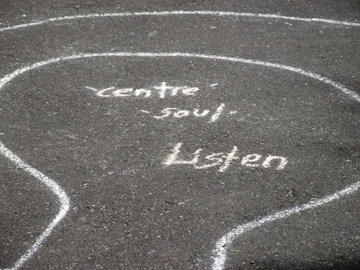

Centering Prayer
I came to know Lorie in person through a Listening Prayer weekend at her home. My spiritual life was challenged and enriched by Lorie’s teaching and she certainly practices what she teaches as I got to know the wonderful community that she draws towards herself. Her longings to deepen and enliven other’s relationship with God, resulted in her terrific book, Invited, Simple Prayer Exercises for Solitude and Community (Fresh Wind Press, 2010). It is a privilege to know her!
Getting to know Lorie:
“I live in Abbotsford with Dwight, my wonderful husband of 33 years. We have five children, now grown, one is married, one still in high school, 3 moved out of town and our first grandchild who thankfully is here in town near Grammy and Papa!!! I enjoy quiet time with God, meaningful times with my family, fun times with friends, divine moments with those I meet. I am a spiritual director, an ordained pastor on staff at Fresh Wind Christian Fellowship.”
“It is my desire to continue to join God in The Way of Love (the life of Jesus), Peace (personal and community), Healing (for the whole person), Grace (unearned redemption), Justice (co-suffering and restorative), Stillness (silence and solitude), and Intimacy with God (ever enlarging union and abiding with God in Christ). High values for me are living and working closely in community with mutual love and acceptance, serving people from all walks of life as led by the Spirit of God. My main hope for the future is to be present to God and the Kingdom of God and welcome Jesus whenever and however he may appear.”
Lorie graduated in 2007 from SoulStream which is a contemplative community that trains spiritual directors and has formed a disbursed contemplative community. Lorie has offered spiritual direction to many who come to retreats or are retreating guests at MARK Centre in Abbotsford. She has a private practice from her home where she meets clients regularly for the past 5 years. Click here to learn more about spiritual direction and read some of Lorie’s articles.
Visit Lorie’s new Website at http://www.loriemartin.com
Centering Prayer
by Lorie Martin of Abbotsford, B.C.

Chalk Labyrinth by Cathy Hardy, Pender Island
My favourite contemplative practice, far above all of my favourites, is Centering Prayer. In this quiet 20 minutes with God the purity and simplicity of being with the Divine Presence is most practical and mystical all at the same time. I’ll share the essence of it in this post; however, click here for more information and details for a full understanding.
Posture: Sitting straight in a chair with feet squarely beneath you and hands relaxed on your lap.
Begin: Ask the Holy Spirit to give you, or you choose a “sacred word” such as Father, Jesus, Abba, Holy One, Love ……. which will be used to bring you back to an awareness of God’s presence when you’ve wandered away in a thought that comes to mind in the quiet. Set a timer for 20 minutes so you can enter in without time being a distraction.
Continue: Sit quietly in God’s presence with an awareness of Divine Love being with you. Thoughts, pictures, prayers, etc. will come to your mind in the quiet, which they are supposed to in all thinking beings. Lightly as a feather you are invited to let the thoughts go for now and gently say the sacred word you’ve been given one time to bring you back to an awareness of God. The goal is Presence.
Some times in Centering Prayer will seem to go so very well, other times it may feel useless and unproductive. However, the joy is being with God without either needing any interaction (there are other times for conversation, intercession, healing, etc.) – this is about purely being together. A most beautiful gift to give God and to receive for yourself.
Utilizing Music in Contemplative Ways
I met Paul Jones as part of my graduating class of spiritual directors. He and his wife Mary have been married for 30 years. He is the father of 2 sons, ages 19 and 23 years. He is a pastor, musician and spiritual director serving in Gig Harbor, Washington, at Peninsula Baptist Church. With a passion for the Word and Worship, he seeks to draw people to a deeper intimacy and communion with the Lord. I found him to be a wonderfully sensitive person who is a great listener and who can play the piano superbly. There was not much of a chance to hear him play the piano in our busy schedule but when he did, I thoroughly enjoyed both the music and Paul’s way of becoming a part of the music and becoming lost in the presence of God. I think this is reflected in the posting that he shares with us as he teaches even those of us who would not claim to be musical to use music as an honest expression, from the heart, of celebration and praise.
Utilizing Music in Contemplative Ways
By: Guest poster, Rev. Paul B. Jones
Even the most cursory review of the Psalms makes it evident that music plays a profound role in times of both personal and corporate worship. From the beginning, our creative God and Savior rejoices in the full range of honest expression from the heart – from deepest sorrow and lament (such as Psalm 42, 130, 137) to the highest of praise and celebration (Psalm 95-100, 150 and many others). Repeatedly, the call goes out to “Sing to the Lord a new song”. As we take the time to wait upon the Lord, a song arises within us. Let it come forth, an honest expression of the heart before the One who knows and loves us best.
 For me, that time of waiting before the Lord and expressing my heart to Him flows best when I sit at a piano. Sometimes I may be playing songs I know; other times, I just play, and/or have the scriptures open – and sing them freely. It need not be polished or refined. In fact, I believe God delights in the raw and honest expression of my faith as I wait upon the Lord in rich and intimate communion with Jesus.
For me, that time of waiting before the Lord and expressing my heart to Him flows best when I sit at a piano. Sometimes I may be playing songs I know; other times, I just play, and/or have the scriptures open – and sing them freely. It need not be polished or refined. In fact, I believe God delights in the raw and honest expression of my faith as I wait upon the Lord in rich and intimate communion with Jesus.
Whatever one’s abilities may be, I encourage you to heed God’s invitation to you to draw near … in a new song… in the free expression of your love to the Lord as you delight in Him – His Word and His work in your life.
Perhaps you feel like you were left out when the gifts of music were distributed. Have no fear. God delights to hear the song of your heart. If that still seems too much of a stretch for you, don’t forget the added blessing of recordings. A practice that helps me to center and attune to God’s presence is silent, contemplative prayer – with the backdrop of quiet, instrumental, reflective music. There are so many to choose from, I hesitate to mention any, knowing one’s preferred style may vary greatly. That said, however, I do offer titles of two artists that have recently enriched my times of communion with God. Songs from the River, by Ruth Fazal; and Keith Duke – His Celtic Music for Piano, featuring Kevin Duncan. Experiment… Try something different or new… and rejoice to hear God singing over you in love.
May these thoughts serve to stimulate your own ideas for utilizing music in the enhancement of your contemplative ways.
Lectio Divina as a Life Practice
I am honoured to have Christine Paintner as a guest poster on our contemplative ways blog. I almost met Christine in person at a workshop she was giving entitled, Awakening Creativity in Soul Care. That was rescheduled but I will still have that privilege at the end of January. When I emailed Christine to let her know what I was doing with the blog, she was immediately gracious in her acceptance and so we have a wonderful Contemplative Ways Posting by Christine. I love her book, “Awakening the Creative Spirit: Bringing the Arts to Spiritual Direction” and I would recommend it to those who are spiritual directors and have not read it so far. And of course, along with this posting, you will find her book, “Levtio Devina – the Sacred Art…” to be a great resource as you continue this practice. You can purchase these books and others through her website as well as partake of some great educational experiences. Christine Valters Paintner, PhD, REACE, is the online Abbess at Abbey of the Arts, an online monastery offering classes, books, and other resources to support contemplative practice and creative expression. She is the author of five books including: The Artist’s Rule: Nurturing Your Creative Soul with Monastic Wisdom, Lectio Divina—The Sacred Art: Transforming Words and Images into Heart-Centered Prayer, and Awakening the Creative Spirit: Bringing the Arts to Spiritual Direction. Her next book will be on the desert mothers and fathers (being published by SkyLight Paths in summer 2012). She earned her PhD in Christian spirituality from the Graduate Theological Union in Berkeley and her professional status as a Registered Expressive Arts Consultant and Educator through the International Expressive Arts Therapy Association. Christine lives as a monk in the world and an artist of everyday life in the heart of Seattle with her husband John and her dog Winter.
Lectio Divina as a Life Practice
By: Christine Paintner
 When I first was introduced to the practice of lectio divina many years ago I felt an opening inside of me, as if I was being met right where I was. I discovered in this ancient way of praying a mirror of my own inner movements and longing for contemplative depth. I felt supported in a way of savoring life and listening deeply for the voice of Spirit moving through sacred texts and the world.
When I first was introduced to the practice of lectio divina many years ago I felt an opening inside of me, as if I was being met right where I was. I discovered in this ancient way of praying a mirror of my own inner movements and longing for contemplative depth. I felt supported in a way of savoring life and listening deeply for the voice of Spirit moving through sacred texts and the world.
Lectio divina has four movements or stages to it which invite us into a place of savoring life and our experience and to discover God’s invitation to us in the midst of that savoring.
Shimmering
The first movement is to read the sacred text and listen for a word that shimmers or catches my attention. I do this as I sit to pray each morning with my scripture reading, but also as I move through the day I find that there are moments that shimmer forth: a friend offers me an unexpected insight, I gaze upon my sweetly sleeping dog, I go for a long walk and find the gathering of crows cawing stirs something in my heart, my husband reaches for my hand and in that moment I feel so deeply loved. We all have these shimmering moments calling to us each day if we pay attention. Through lectio I cultivate the capacity to notice these and honor them as important, as sacred.
Savoring
The second movement is reflection which involves taking what shimmers into my heart and allowing it to unfold in my imagination. I savor the images, feelings, and memories which arise. Our lives are so rushed, that savoring can become a counter-cultural practice. In my morning prayer I make space to just notice what experience is rising up in me, and in my daily life I become attentive to those experiences which stir strong feelings or trigger an unexpected memory. Perhaps I am driving in my car and a song comes on the radio which carries me back in time to a moment from my past and I am filled with emotion. Lectio cultivates my ability to make space to allow the fullness of my experience. Rather than holding back my tears and judging them, I let them flow and in the process discover a moment of healing and grace.
Summoning
The third movement is about responding to our prayer and listening for God’s invitation in this moment. In my morning practice I sit and wait as the word that shimmers and the images, feelings, and memories which have unfolded in my prayer begin to yield a sense of God’s longing for my life. In my daily life I notice when my heart is touched by an encounter and I sense that God is summoning me into something new through this very moment. I can’t know what that new thing is just yet, it is often more of an intuition. Sometimes it happens after I teach a class and I have expressed something in a new way and I surprise myself by my own words or a student asks a probing question which breaks open the subject in ways I hadn’t considered. These are moments of divine invitation and lectio helps me to respond.
Stilling
The fourth movement is about going more deeply into a space of rest and stillness. In my morning prayer I simply sit in silence for several minutes, basking in the experience of being rather than doing and feeling full of gratitude for this gift. As I move through my day I am touched by the moments of stillness I find in the midst of life’s busyness. I go for a walk and come upon a radiant dahlia blooming and I am stopped in my tracks, breathing in for just a moment the beauty of dahlias. I am sitting with someone who is sharing her deepest struggles and both of our eyes become wet with tears and we simply pause for a few moments to rest into the silence which holds us both.
Lectio and Life
After almost twenty years of practicing lectio divina, I see the world differently. Each moment and thing has the potential to become a vehicle for revelation. Lectio divina has changed my life. Instead of being something I practice for twenty minutes each morning it has become a way I experience and move through the world. Instead of feeling bound to a particular structure and sequence of steps, I discover that each movement of lectio has its own gift and rhythm and I open my heart to when it will be revealed in my day. The practice of a spiritual discipline is about more than the minutes we spend doing it, but how it overflows into the whole of life.
We might ask ourselves, is my vision changed because of this practice? If not, how might I let its gift be unleashed into each moment.
Praying With Food
I met Pearl as part of my spiritual direction training. I found her to be creative, intuitive and a wonderful listener. She has such a warm way of drawing you in to her. Using this creativity and warmth, we are fortunate that Pearl will be sharing a unique way of being contemplative with us. Pearl Nieuwenhuis is the sister of 8 siblings, is a wife of 25 years, the mother of 2 university students, has a history as a teacher in both public and private schools, as a home schooler and as a home education consultant. She is currently working as a spiritual director both at the University of Calgary Faith and Spirituality centre as well as in her home. She loves reading, having meaningful conversations, experimenting with food and playing squash. She reports that at this time in her life, she is paying special attention to God’s loving invitations in her life – to trust, to be open and receptive, to being fully alive to new ideas and people, to accept difficult things and much more! I know you will enjoy this posting (I loved it!) and can immediately taste of this contemplative way!
Praying with Food – A Contemplative Way of Being
By: Pearl Nieuwenhuis
A few years ago someone told me that she felt a great closeness to God when she donned her hockey equipment and played a game of hockey. It was what she experienced as a body prayer. That telling opened up a world of possibilities as I wondered what a prayer using my body might look like for me. As I reflected about my days and some of the things that awakened my bodily senses, awareness of myself and openness to God’s presence, I noticed how I kept thinking about cooking. I love food. I love the colors, textures, smells, and tastes of so many foods. And, I notice how my heart sings a song of delight and gratitude when I have time to enjoy them. I wondered if cooking could be a time when I feel a great closeness to God and experience it as a body prayer. I decided to experiment and over the past year I’ve selected an intentional time to commune with God as I cook and call it praying with food. In a gently held routine, I allow a time where I can make something yummy and allow my heart to open up to what God might have to offer me during this time. Even though I love food and enjoy cooking, what comes to me as I contemplate isn’t always delight and gratitude. Sometimes I have a strong sense that God is asking me to pay attention to something uncomfortable. Paying attention. Yes, that is really what this practice is about; slowing down and in the paying attention allowing something of God to move me. What I’ve written below is from my journal after a time of “praying with food”.
 “I’ve just made 33 bean and beef burritos for my praying with food day. The onions were crisp and crunchy – easy to chop, sharp to the eyes but smelled so yummy while frying in real butter – turning a translucent something before I added a mixture of legumes. Legumes. They’re so earthy. So filling. Versatile and nutritious. They’ve been uninteresting until now. And, admittedly, even ‘beneath me’ until now. A poor man’s food. I looked closely at one probably for the first time in my life. It was beautiful and perfect. I was surprised at how moved I was by noticing this seed and a small yet perceptible shift took place in me as I recognized God’s creative care for people; for me. Garbanzo and black, white and red beans along with some onion powder, chilli powder, cumin and garlic. 5 pounds of fried ground beef and several teaspoons of salt added to the bean/onion mixture and several cups of shredded cheese – what a hearty and tasty filling for the whole-wheat flour tortillas. I tried not to just get it done but be grateful for those who had toiled so I could enjoy. Hmmmm, I wondered who tended and gathered the chilli peppers and cumin seeds? I wanted to appreciate them….would they ever know that some stranger appreciates them? I felt grateful for the farmers who raised cows and milked them, and for those who added the rennet to make the cheddar cheese. I didn’t actually think about the cows – hmmmm– I think I try not to because I don’t like the idea of killing cows and also because how I felt about cows growing up on a farm. They were big and smelly, a nuisance to feed and water. Scary. I never really thought about caring for them. God, do you care about cows? Should I care about cows? Would I eat differently if I did? What is it about animals and their muscle that we like to eat it so much? I certainly loved the burrito mixture – it was absolutely delectable but what about those cows? And, come to think of it, what about all the people in the world who cannot afford to buy meat and benefit from the protein it offers? Does my consumption affect the health of others? Does it harm others? These questions have been running through my mind in a newly awakening way. In the midst of mixing the burrito ingredients together I stopped and waited. It was like God said “Yes, I do care for cows.” And I knew it to be true. Of course God cares for cows. And legumes. And farmers. And me.”
“I’ve just made 33 bean and beef burritos for my praying with food day. The onions were crisp and crunchy – easy to chop, sharp to the eyes but smelled so yummy while frying in real butter – turning a translucent something before I added a mixture of legumes. Legumes. They’re so earthy. So filling. Versatile and nutritious. They’ve been uninteresting until now. And, admittedly, even ‘beneath me’ until now. A poor man’s food. I looked closely at one probably for the first time in my life. It was beautiful and perfect. I was surprised at how moved I was by noticing this seed and a small yet perceptible shift took place in me as I recognized God’s creative care for people; for me. Garbanzo and black, white and red beans along with some onion powder, chilli powder, cumin and garlic. 5 pounds of fried ground beef and several teaspoons of salt added to the bean/onion mixture and several cups of shredded cheese – what a hearty and tasty filling for the whole-wheat flour tortillas. I tried not to just get it done but be grateful for those who had toiled so I could enjoy. Hmmmm, I wondered who tended and gathered the chilli peppers and cumin seeds? I wanted to appreciate them….would they ever know that some stranger appreciates them? I felt grateful for the farmers who raised cows and milked them, and for those who added the rennet to make the cheddar cheese. I didn’t actually think about the cows – hmmmm– I think I try not to because I don’t like the idea of killing cows and also because how I felt about cows growing up on a farm. They were big and smelly, a nuisance to feed and water. Scary. I never really thought about caring for them. God, do you care about cows? Should I care about cows? Would I eat differently if I did? What is it about animals and their muscle that we like to eat it so much? I certainly loved the burrito mixture – it was absolutely delectable but what about those cows? And, come to think of it, what about all the people in the world who cannot afford to buy meat and benefit from the protein it offers? Does my consumption affect the health of others? Does it harm others? These questions have been running through my mind in a newly awakening way. In the midst of mixing the burrito ingredients together I stopped and waited. It was like God said “Yes, I do care for cows.” And I knew it to be true. Of course God cares for cows. And legumes. And farmers. And me.”
What kind of body prayer might fit for you? If you are interested in trying something other than folding your hands in devotion or lifting your hands in praise, consider when you quite naturally awaken to your senses, your body. Might you use these times to listen and pay attention to what God may be inviting you to?
The Labyrinth as a Contemplative Practice
I have had the privilege of doing some spiritual direction training with Brent Unrah on a number of week long intensives. I found Brent to have a wonderfully WELL developed sense of fun and is a great ‘outside of the box’ thinker. He is an art appreciater and creator and brought lots of unique wisdom to our training. I really appreciate and like who he is. I hope you get to know him somewhat from his postings for us on this Blog. Brent Unrah lives on Kingfisher Farm (a community living farm) in South Surrey with his wife (Denise) of 28 years, they have two grown children. He divides his time between his counselling practice with Coastal Counselling Services (Whalley/Surrey area, new website under development), his Pastiche Art company, and his involvement with Oasis Retreats as Birkman consultant and workshop facilitator. He will complete the Soulstream Art of Spiritual Direction course this Spring and has been deeply impacted by his contemplative journey and looks forward to how this will be integrated into his life. He has a passion to weave together the text of Gods word, his life story and the culture around him (books, poetry, plays and movies) and can often be found at Small Ritual Coffee Society drinking up a lively conversation.
The Labyrinth as a Contemplative Practice
by: Brent Unrah
You can find Labyrinths in your area by visiting
St. Hilda’s By The Sea or through the graciousness of Brent (see below).
 For those who want to come to our Kingfisher Farm (512-172nd Street, Surrey) to walk the Labyrinth they simply need to Email me at:
For those who want to come to our Kingfisher Farm (512-172nd Street, Surrey) to walk the Labyrinth they simply need to Email me at:
or phone 604-531-0260 to arrange a time to visit. The concern for us at the farm is having random people on the property without any sense of connection to anyone. So as long as those who want to come contact me first to arrange an appointment, that would be great. I will just welcome you and give you a sense of where the labyrinth is and then leave you to enjoy the experience on your own.
My basic simple thought was to offer this as a hands on (feet on) way to worshipfully remember Gods gracious presence with us through the journey of this past year with all its surprises, turns and twists and to anticipate His presence with us as we begin the adventure of a new years journey. Enjoy the experience. I have included some labyrinth reading material below for your general understanding. I hope that you find it useful.
The labyrinth path has three stages – the ‘inward’ journey, the centre and the ‘outward’ journey. The theme of the ‘inward’ journey is letting go of things which hinder our wholeness and inner approach to God. The centre of the Labyrinth is a space of meditative prayer and peace. The theme of the ‘outward’ journey is relationship – with ourselves, with others and with the planet – seen in the light of our relationship with God.
Labyrinths and mazes have often been confused. When most people hear of a labyrinth they think of a maze. A labyrinth is not a maze. A maze is like a puzzle to be solved. It has twists, turns, and blind alleys. It is a left brain task that requires logical, sequential, analytical activity to find the correct path into the maze and out.
A labyrinth has only one path. It is unicursal. The way in is the way out. There are no blind alleys. The path leads you on a circuitous path to the center and out again.
A labyrinth is a right brain task. It involves intuition, creativity, and imagery. With a maze many choices must be made and an active mind is needed to solve the problem of finding the center. With a labyrinth there is only one choice to be made. The choice is to enter or not. A more passive, receptive mindset is needed. The choice is whether or not to walk a spiritual path.
At its most basic level the labyrinth is a metaphor for the journey to the center of your deepest self and back out into the world with a broadened understanding of who you are.
Things to keep in mind before walking a labyrinth:
- Preparation: Becoming clear about the focus on the labyrinth prayer
- Invocation: Asking God’s help as one begins
- Going in: Moving on the path from the threshold (entrance) to the center
- Staying in the center: Resting for as long as one likes
- Returning to the world: Moving on the path from the center to the threshold (entrance)
- Thanksgiving: Giving thanks for what has been experienced
- Reflection: Taking time to understand the deeper meanings of the labyrinth prayer
The Lord’s Prayer
Our first posting is from Rob Des Cotes. I have been privileged to be at one of Rob’s wonderful weekend retreats. Rob is a spiritual director, retreat leader and pastor of Fairview Baptist Church in Vancouver, B.C. He also directs Imago Dei, a network of faith communities that encourages the practice of prayer and a transforming relationship with God. He is the author of three books of meditations for spiritual direction, Fan the Flame, Higher Than I and Ultreia! (Go Higher). This posting was written for a whole week, beginning on a Monday. You will have four days to go through this, starting today, Sunday, in order to have a taste of ‘Lectio Devina’ using the Lord’s Prayer.
New Years blessings to each one of you!
Praying the Lord’s Prayer
Lord, teach us to pray. Luke 11:1
The Lord responded to this request by teaching His disciples what we now call “the Lord’s Prayer.” Ever since, these words have become the central utterance of the historical church. They are words that we are meant to embody as our first concerns of life. It is a beautiful prayer to recite, but it is in living each of these petitions that the power of these words becomes rooted in our thoughts, attitudes, actions and desires. Through these words we line up our desires with those of our Lord.
I have longed to shape my life according to this prayer and have been helped by a simple format that might serve you as well. Whenever I have tried to meditate on the various petitions during a single prayer time I have always found it overwhelming. Each verse is a lectio divina of its own. But the Lord’s Prayer can easily be walked through on a weekly basis, focusing on one meditation each day. A relationship with the Lord’s Prayer over the course of a week could look like this:
Monday: “Our Father who art in heaven, hallowed be thy name”
- consider today the many ways God nurtures us
- consider how the word our presumes a relationship with God that is a shared one
- meditate on the fact that, though God is with us and within us, He is also high above us. He is both immanent and transcendent
- consider your relationship to a God whose name is hallowed, holy
Tuesday: “Thy kingdom come, thy will be done on earth as it is in heaven”
- meditate on the need for change in the world
- consider the difference it will make and desire the day when every person will know the Lord for themselves. (Jer. 31:34)
- rejoice at the hope of everything being as it should; imagine the unity of agreement between heaven and earth, and among all people
Wednesday: “Give us this day our daily bread”
- it is half way through the week; pray for the conditions of your home or work place
- meditate on your circumstances, whether in need or in plenty, and consider all to be from God’s hand
- give thanks to God for the needs you do have; see yourself among those who are blessed because you hunger God-ward.
Thursday: “Forgive us our trespasses”
- the week now turns towards Sunday when you will once again meet the Lord in communion; it is time to “prepare the way of the Lord”
- spend time today taking stock of your life; confess all that represents a trespass of God’s loving desire for your life
- consider the ways your life has either intentionally or inadvertently worked against God’s purposes in you, and in your relationship with others
- be grateful for the confidence you have in asking for forgiveness; and for the assurance you have that you will receive it
Friday: “as we forgive those who trespass against us”
- Friday, in many Christian traditions, is considered a day of mercy since it was the day the Lord gave His life for us. As we have freely received mercy when we asked for it yesterday, today we consider all those who offend us as we pray for the faith to forgive them
- as Christ does for you, present others to yourself as “spotless, without blemish” (Eph. 5:27)
- forgive yourself also, for all the ways you think you fail in your own eyes
Saturday: “And lead us not into temptation but deliver us from evil”
- Saturday, in most Christian traditions, is seen as a day of waiting, as it lies between Good Friday and Resurrection Sunday
- in the days preceding, you have asked for and have received forgiveness. Jesus now says to us, “go and sin no more.” Today is a day when you strive to remain in His love, clean because of the grace you have received from His hand
- let us not underestimate the daily help we need in order to continually walk in righteousness
Sunday: “For thine is the Kingdom, the power and the glory forever and ever, Amen.”
- the Lord’s Day is a day of victory that affirms God’s rule over sin and death
- we meditate on eternity, when God’s glory will no longer be seen dimly, but will be fully recognized by all
- rest in the confidence that God’s sovereign power will achieve all that He has promised.







